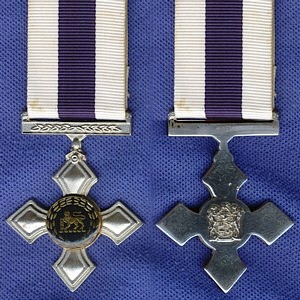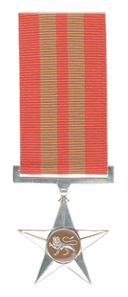
The Nkwe ya Gauta - Golden Leopard, post-nominal letters NG, is a military decoration for bravery which was instituted in 2003, to replace the Honoris Crux Gold (HCG). It is South Africa's highest military decoration for bravery.

The Nkwe ya Boronse - Bronze Leopard, post-nominal letters NB, is a military decoration for bravery which was instituted in 2003. It is South Africa's third highest military decoration for bravery.

The iPhrothiya yeGolide - Golden Protea, post-nominal letters PG, was instituted by the President of the Republic of South Africa on 16 April 2003 and came into effect on 27 April 2003. It can be awarded to all ranks who have distinguished themselves by exceptional leadership or exceptional meritorious service and the utmost devotion to duty. It is South Africa's highest existing military decoration for meritorious conduct.

The iPhrothiya yeSiliva - Silver Protea, post-nominal letters PS, was instituted by the President of the Republic of South Africa on 16 April 2003 and came into effect on 27 April 2003. It can be awarded to all ranks who have distinguished themselves by outstanding leadership or outstanding meritorious service and particular devotion to duty. It is South Africa's second highest existing military decoration for meritorious conduct.

The iPhrothiya yeBhronzi - Bronze Protea, post-nominal letters PB, was instituted by the President of the Republic of South Africa on 16 April 2003 and came into effect on 27 April 2003. It can be awarded to all ranks who have distinguished themselves by leadership or meritorious service and devotion to duty.

The Honoris Crux Gold, post-nominal letters HCG, is a South African military decoration for bravery which was instituted in 1975. It was awarded to members of the South African Defence Force for outstanding acts of bravery while in extreme danger. It was the second most senior in a set of four classes of Honoris Crux decorations which replaced the discontinued Honoris Crux of 1952.

The Honoris Crux Silver, post-nominal letters HCS, is a military decoration for bravery which was instituted by the Republic of South Africa on 1 July 1975. It was awarded to members of the South African Defence Force for exceptional acts of bravery while in great danger. The Honoris Crux Silver was the third most senior in a set of four classes of Honoris Crux decorations, which together replaced the discontinued Honoris Crux of 1952.

The Navy Cross, post-nominal letters CN is a military decoration which was instituted by the Republic of South Africa in 1987. It was awarded to members of the South African Navy for bravery. It was discontinued in 2003, but backdated awards can still be made for acts of bravery during this period.

The Pro Virtute Decoration, post-nominal letters PVD, is a military decoration for bravery which was instituted by the Republic of South Africa in 1987. It was awarded to officers of the South African Defence Force for distinguished conduct and exceptional leadership during combat operations in the field.

The Ad Astra Decoration, post-nominal letters AAD, was instituted by the Republic of South Africa in 1991, to reward South African Air Force aircrew members on board aircraft for excellent airmanship or outstanding ingenuity or skill during emergencies or critically unusual situations in the air. It was discontinued in 2003, but backdated awards can still be made for acts performed during the period in effect.

The Honoris Crux of 1975, post-nominal letters HC, is a military decoration for bravery which was instituted by the Republic of South Africa on 1 July 1975. The decoration was awarded to members of the South African Defence Force for bravery in dangerous circumstances. It was the junior in a set of four Honoris Crux decorations in four classes, which together replaced the discontinued Honoris Crux of 1952.

The General Service Medal was instituted by the State President of the Republic of Bophuthatswana in 1991, for award to all ranks for operational service inside Bophuthatswana.

The Nkwe Medal was instituted by the State President of the Republic of Bophuthatswana in 1990, for award to all ranks for operational service.

The Distinguished Gallantry Medal was instituted by the State President of the Republic of Bophuthatswana in 1982, for award to all ranks for extraordinary gallantry.

The Gallantry Cross, Silver, post-nominal letters GCS, was instituted by the President of the Republic of Venda in 1985, for award to all ranks for courage or bravery or valour beyond the normal call of duty.

The Venda Defence Force Medal was instituted by the President of the Republic of Venda in 1984, for award to all ranks for service of a high standard.

The Star for Bravery in Gold, post-nominal letters SBG, was instituted by the President of the Republic of South Africa in April 1996. It was awarded to veteran cadres of Umkhonto we Sizwe, the military wing of the African National Congress, who have distinguished themselves during the "struggle" by performing acts of exceptional bravery in great danger.

The Star for Bravery in Silver, post-nominal letters SBS, was instituted by the President of the Republic of South Africa in April 1996. It was awarded to veteran cadres of Umkhonto we Sizwe, the military wing of the African National Congress, who had distinguished themselves during the "struggle" by performing acts of bravery.

The Conspicuous Leadership Star, post-nominal letters CLS, was instituted by the President of the Republic of South Africa in April 1996. It was awarded to veteran cadres of Umkhonto we Sizwe, the military wing of the African National Congress, who have distinguished themselves during the "struggle" by distinguished conduct and exceptional combat leadership.

The Service Medal in Bronze was instituted by the President of the Republic of South Africa in April 1996. It was awarded to veteran cadres of Umkhonto we Sizwe, the military wing of the African National Congress, for ten years service.























